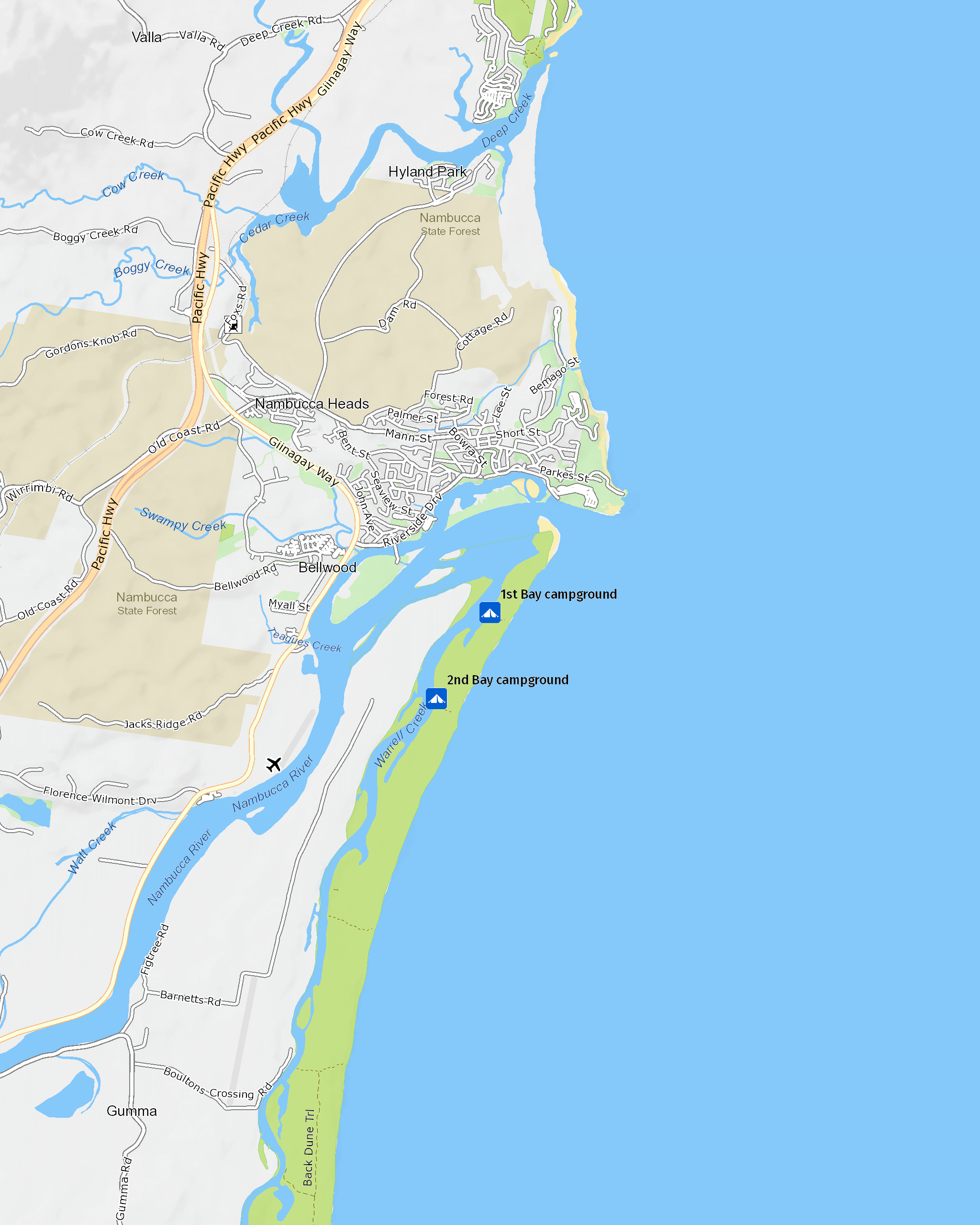1st Bay campground
Gaagal Wanggaan (South Beach) National Park
Overview
Stay at 1st Bay campground in Gaagal Wanggaan National Park near Coffs Harbour. This small North Coast campground can only be reached by boat.
1st Bay campground can comfortably fit 6 to 8 people, but is best suited to a single family. It has 1 wood barbecue and no other facilities.
The only way to reach this campground is by boat along Warrell Creek.
You can leave your car at Weir Reserve, Scotts Head or near the boat ramp at Stuart's Island, accessed via Bellwood Park on Riverside Drive. These areas are not part of the Gaagal Wanggaan National Park - parking is unmonitored and at your own risk.
You must bring a portable toilet when camping here, all waste must be taken with you when you leave.
There are no camping fees at this campground, but a $6 booking fee applies. Bookings are required. Book online or call the National Parks Contact Centre on 1300 072 757.
It's a good idea to let someone know where you're going. Fill in a trip intention form to send important details about your trip to your emergency contact.
Nearby
-

Warrell Creek
Warrell Creek offers opportunities for kayaking, canoeing and fishing, with nearby places to picnic and secluded camping sites
-

2nd Bay campground
Stay at 2nd Bay campground in Gaagal Wanggaan National Park near Coffs Harbour. This small North Coast campground can only be reached by boat.
These maps give a basic overview of park attractions and facilities, and may not be detailed enough for some activities. We recommend that you buy a topographic map before you go exploring.
Map

Map legend

Local alerts
For the latest updates on fires, closures and other alerts in this area, see https://www.nationalparks.nsw.gov.au/camping-and-accommodation/campgrounds/1st-bay-campground/local-alerts
Bookings
- National Parks Contact Centre
- 7am to 7pm daily
- 1300 072 757 (13000 PARKS) for the cost of a local call within Australia excluding mobiles
- parks.info@environment.nsw.gov.au
Operated by
- Coffs Harbour office
- Monday to Friday, 8.30am to 4.30pm.
- 02 6652 0900
- npws.coffscoast@environment.nsw.gov.au
- 4/32 Edgar St, Coffs Harbour NSW 2450
Park info
- in Gaagal Wanggaan (South Beach) National Park in the North Coast region
Gaagal Wanggaan (South Beach) National Park is always open but may have to close at times due to poor weather or fire danger.
Visitor info
All the practical information you need to know about 1st Bay campground.
Maps and downloads
Learn more
1st Bay campground is in Gaagal Wanggaan (South Beach) National Park. Here are just some of the reasons why this park is special:
An insect paradise

Making up the bulk of the dry land in the park, sand dunes and dry forests of banksia, blackbutts and scribbly gums encourage a rich undergrowth of shrubs and grasses. Flowers bloom in late winter and early spring, and this attracts a variety of insects and butterflies, including the black grass-dart butterfly. Gaagal Wanggaan is also home to an array of bird species, including white-bellied sea eagles, ospreys, white-faced herons, azure kingfishers and black-necked storks, as well as the endangered little tern.
- Warrell Creek Warrell Creek offers opportunities for kayaking, canoeing and fishing, with nearby places to picnic and secluded camping sites
Enduring Aboriginal culture

Gaagal Wanggaan (South Beach) National Park has tremendous cultural significance for the Gumbaynggirr Aboriginal community of Nambucca Valley, with sites that demonstrate continuous use of the area for thousands of years. Gumbaynggirr People used the lands and waterways for sustenance and ritual practices; they continue to use it today, passing knowledge through generations. In recognition of this living heritage, the national park is jointly managed by the NSW National Parks and Wildlife Service and Aboriginal Traditional Owners. Their contribution and knowledge of the area is central to the management of the park and to educating visitors on Aboriginal culture.
Plants and animals protected in this park
Animals
-

Australian pelican (Pelecanus conspicillatus)
The curious pelican is Australia’s largest flying bird and has the longest bill of any bird in the world. These Australian birds are found throughout Australian waterways and the pelican uses its throat pouch to trawl for fish. Pelicans breed all year round, congregating in large colonies on secluded beaches and islands.
-

Superb fairy wren (Malurus cyaneus)
The striking blue and black plumage of the adult male superb fairy wren makes for colourful bird watching across south-eastern Australia. The sociable superb fairy wrens, or blue wrens, are Australian birds living in groups consisting of a dominant male, mouse-brown female ‘jenny wrens’ and several tawny-brown juveniles.
-

Kookaburra (Dacelo novaeguineae)
Of the 2 species of kookaburra found in Australia, the laughing kookaburra is the best-known and the largest of the native kingfishers. With its distinctive riotous call, the laughing kookaburra is commonly heard in open woodlands and forests throughout NSW national parks, making these ideal spots for bird watching.
Plants
-

Cabbage palm (Livistona australis)
With glossy green leaves spanning 3-4m in length and a trunk reaching a height of up to 30m, the cabbage tree palm, or fan palm, is one of the tallest Australian native plants. Thriving in rainforest margins along the east coast of NSW, in summer this giant palm produces striking spikes of cream flowers which resemble cabbages.
-

Black sheoak (Allocasuarina littoralis)
The black sheoak is one of a number of casuarina species found across the east coast of Australia and nearby tablelands. Growing to a height of 5-15m, these hardy Australian native plants can survive in poor or sandy soils. The barrel-shaped cone of the black sheoak grows to 10-30mm long.